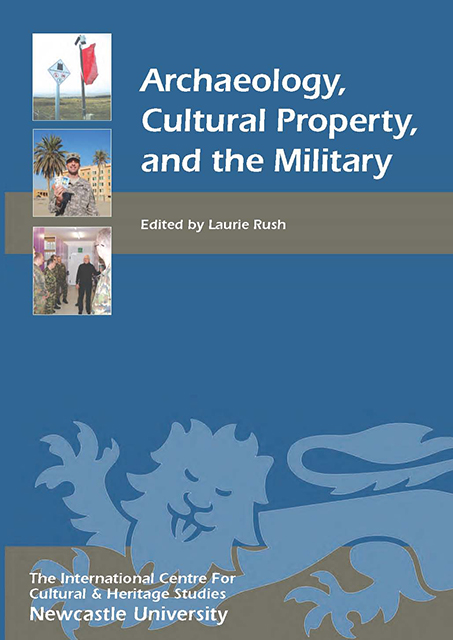Book contents
- Frontmatter
- Contents
- List of Illustrations: Figures and Tables
- Archaeology and the Military: An Introduction
- 1 The Obligations Contained in International Treaties of Armed Forces to Protect Cultural Heritage in Times of Armed Conflict
- 2 Rescuing Europe’s Cultural Heritage: The Role of the Allied Monuments Officers in World War II
- 3 The UK’s Training and Awareness Programme
- 4 US Army Civil Affairs: Protecting Cultural Property, Past and Future
- 5 Cultural Property Protection in the Event of Armed Conflict: Deploying Military Experts or Can White Men Sing the Blues?
- 6 Good Training and Good Practice: Protection of the Cultural Heritage on the UK Defence Training Estate
- 7 In-Theatre Soldier Training through Cultural Heritage Playing Cards: A US Department of Defense Example
- 8 Dealing the Heritage Hand: Establishing a United States Department of Defense Cultural Property Protection Program for Global Operations
- 9 Teaching Cultural Property Protection in the Middle East: The Central Command Historical/Cultural Advisory Group and International Efforts
- 10 Cultural Resources Data for Heritage Protection in Contingency Operations
- 11 Time not on my Side: Cultural Resource Management in Kirkuk, Iraq
- 12 US Military Support of Cultural Heritage Awareness and Preservation in Post-Conflict Iraq
- 13 Operation Heritage
- 14 Cultural Property Protection in the Event of Armed Conflict – Austrian Experiences
- 15 The Role of the Swiss Armed Forces in the Protection of Cultural Property
- 16 Preserving Global Heritage from Space in Times of War
- Appendix 1 1954 Hague Convention and its two Protocols
- Appendix 2 Author Biographies
- Index
1 - The Obligations Contained in International Treaties of Armed Forces to Protect Cultural Heritage in Times of Armed Conflict
Published online by Cambridge University Press: 28 February 2023
- Frontmatter
- Contents
- List of Illustrations: Figures and Tables
- Archaeology and the Military: An Introduction
- 1 The Obligations Contained in International Treaties of Armed Forces to Protect Cultural Heritage in Times of Armed Conflict
- 2 Rescuing Europe’s Cultural Heritage: The Role of the Allied Monuments Officers in World War II
- 3 The UK’s Training and Awareness Programme
- 4 US Army Civil Affairs: Protecting Cultural Property, Past and Future
- 5 Cultural Property Protection in the Event of Armed Conflict: Deploying Military Experts or Can White Men Sing the Blues?
- 6 Good Training and Good Practice: Protection of the Cultural Heritage on the UK Defence Training Estate
- 7 In-Theatre Soldier Training through Cultural Heritage Playing Cards: A US Department of Defense Example
- 8 Dealing the Heritage Hand: Establishing a United States Department of Defense Cultural Property Protection Program for Global Operations
- 9 Teaching Cultural Property Protection in the Middle East: The Central Command Historical/Cultural Advisory Group and International Efforts
- 10 Cultural Resources Data for Heritage Protection in Contingency Operations
- 11 Time not on my Side: Cultural Resource Management in Kirkuk, Iraq
- 12 US Military Support of Cultural Heritage Awareness and Preservation in Post-Conflict Iraq
- 13 Operation Heritage
- 14 Cultural Property Protection in the Event of Armed Conflict – Austrian Experiences
- 15 The Role of the Swiss Armed Forces in the Protection of Cultural Property
- 16 Preserving Global Heritage from Space in Times of War
- Appendix 1 1954 Hague Convention and its two Protocols
- Appendix 2 Author Biographies
- Index
Summary
In April of 2003, as the United States military took control of Baghdad during the second Gulf War, the world soon learned that the Iraq Museum, the world's largest repository of ancient Mesopotamian art and artefacts, had been looted. The United States received almost universal blame for allowing the looting to occur, with some even charging that the United States’ inaction had violated international law. Furthermore, the United States military, in its role of quasi-occupier of Iraq, constructed military bases on, or in other ways utilised for military purposes, culturally and historically sensitive sites at Ur, Babylon and Samarra. During the hiatus in effective law enforcement and the political chaos in the years that followed the initial invasion, archaeological sites, particularly those of the Sumerian period (approximately third millennium BC) in the southern part of Iraq, were looted.
These actions and events pose questions concerning the obligations of a military power to avoid doing harm to cultural heritage and to actively preserve it during armed conflict and occupation. While much controversy and criticism were engendered in the cultural heritage preservation community, and the Gulf War undeniably had a significant adverse effect on Iraq's cultural heritage, it is also likely that these events provided the final impetus, directly or indirectly, for the United States, after a delay of 55 years, to ratify the first international convention to address exclusively cultural property – the 1954 Hague Convention for the Protection of Cultural Property in the Event of Armed Conflict.
HISTORICAL BACKGROUND
The looting and destruction of cultural heritage during and in the wake of warfare has a long history, going back even to ancient times. Cultural looting served to emphasise to the defeated the loss of their political, cultural and religious freedom, and it demonstrated the might of the conqueror in asserting its cultural dominance. The effects of cultural looting are well illustrated in the depiction on the Arch of Titus in Rome of the triumphal procession in which the Menorah and other sacred implements taken from the Second Temple in Jerusalem at the time of its destruction in AD 70 were displayed as war booty (Miles 2008, 260–63).
- Type
- Chapter
- Information
- Archaeology, Cultural Property, and the Military , pp. 4 - 14Publisher: Boydell & BrewerPrint publication year: 2010
- 10
- Cited by



